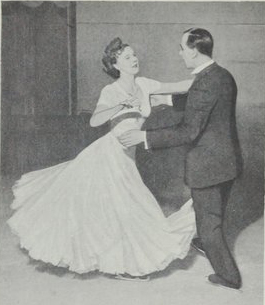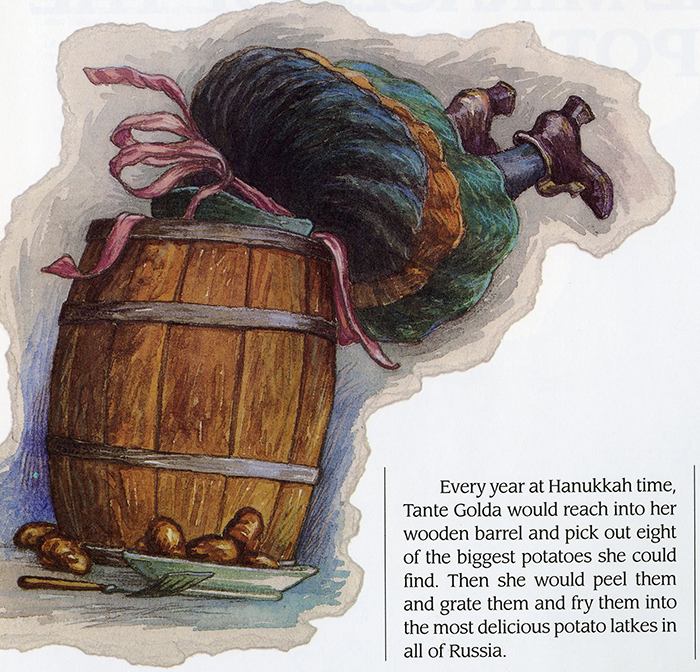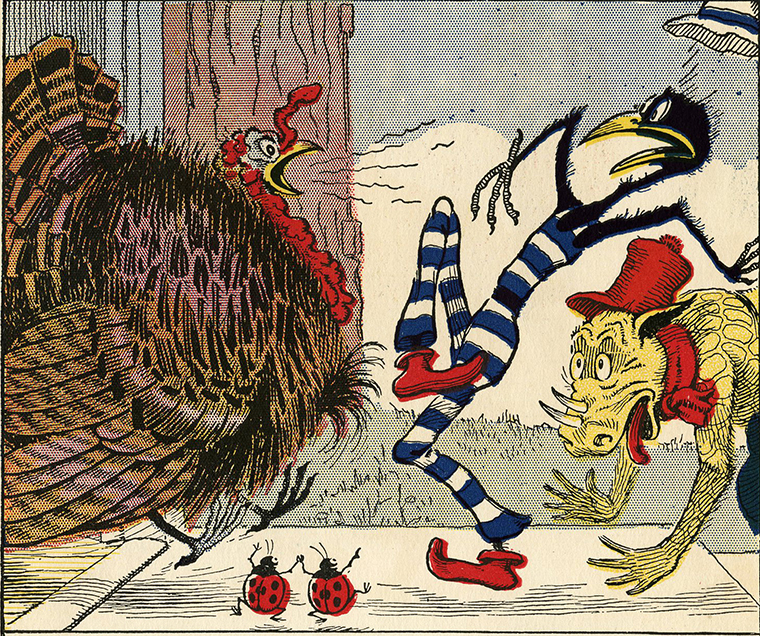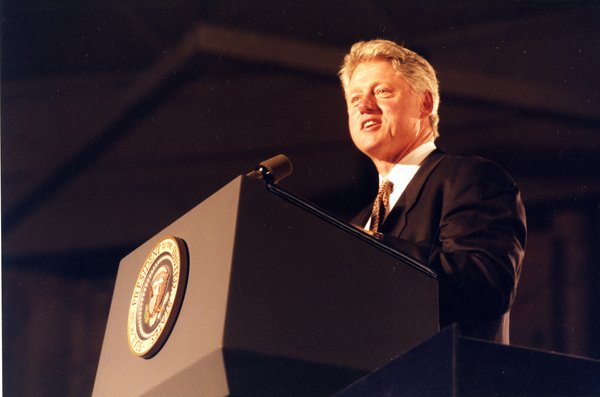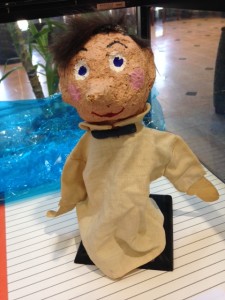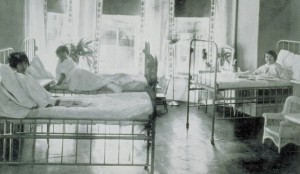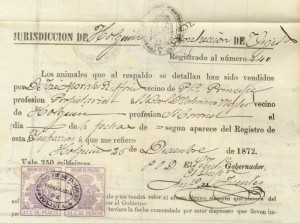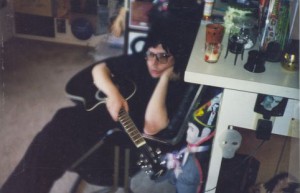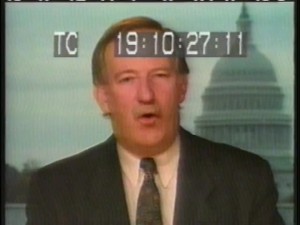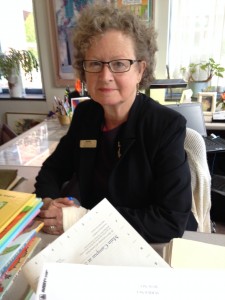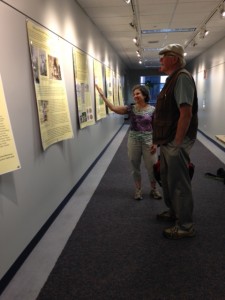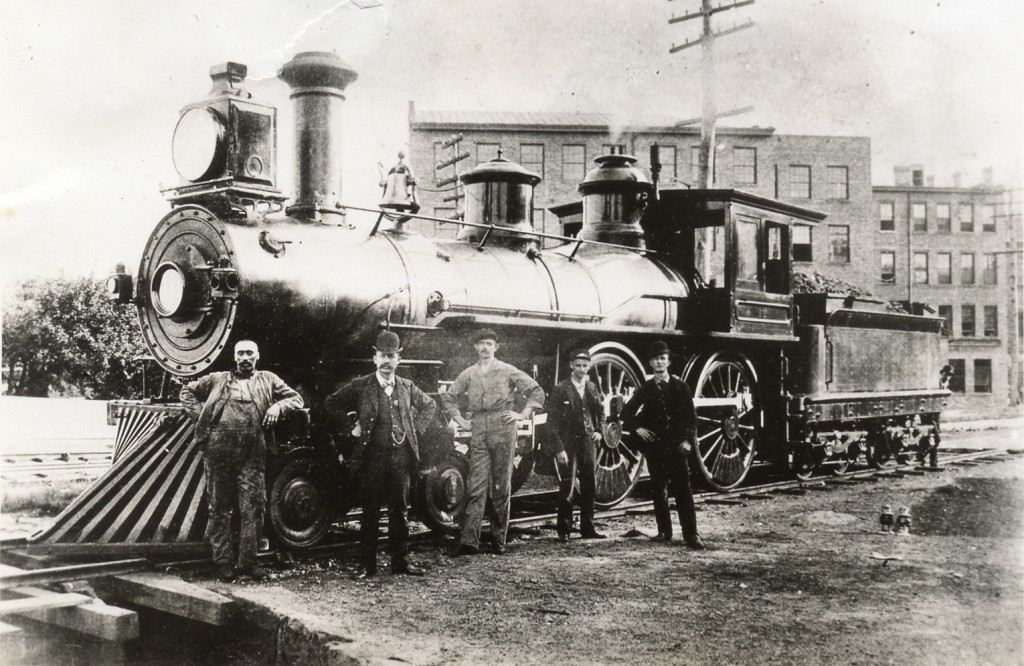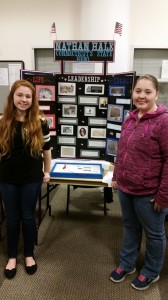It’s National Tango Day! Not in the U.S., though, but in Argentina. That’s as good an excuse as any to put up this photo of a couple dancing a tango on ice from the book “Dancing on Ice,” which you can find in our digital repository.
Author Archives: Laura Smith
Happy Hannukah!
Here is a page from one of the many holiday books that you can find in the Northeast Children’s Literature Collection. The Miracle of the Potato Latkes: A Hanukkah Story, was written in 1994 by Malka Penn and illustrated by Giora Carmi. This page from the book is shown here courtesy of the author and illustrator.
Happy Thanksgiving!
Veteran’s Day, UConn style
More than 2000 UConn alumni served in World War II; 114 of them lost their lives in the conflict. After the war the Veteran’s Administration requested that the university accept between 3000 and 4000 returning soldiers as students. In 1946 the campus had 792 veterans enrolled as students (11 of them were women) with another 300 at the Hartford and Waterbury extension campuses and 154 are enrolled in the Law, Insurance and Pharmacy schools. Eleven temporary barracks, nicknamed “Siberia” because of their distance from the main campus, were built on “the site of the former agronomy plots bordering the main road to Willimantic.” This site is now the Fine Arts Complex and E.O. Smith High School. As more veterans were accepted to UConn more housing was built or found in nearby Willimantic.
Bill Clinton back on campus to accept the Dodd Prize
President Bill Clinton came to the University of Connecticut in 1995 to dedicate the Thomas J. Dodd Research Center. He returns today, exactly twenty years later, to receive the Thomas J. Dodd Prize in International Justice and Human Rights, along with the international Human Rights Education organization Tostan. We’re delighted to welcome him back to UConn! Here he is at the ceremony on October 15, 1995.
Does UConn still offer blacksmith classes?
Puppets in the reference room!
In support of the National Puppetry Festival, we have joined other exhibition venues on campus to show off puppet related materials in our collection. In the reference room you’ll see books describing how to make puppets of all kinds and the theaters and plays to go with them as well as hand puppets from the Phyllis Hirsch Boyson Artifact Collection. The show will be up through August 31.
You can view the puppet exhibit during the hours that our reference room is open: Monday through Friday, 9a.m. to 4p.m.
“The most important value of the practice of puppetry for a child is his introduction to the world of art. In his work, a puppeteer creates and uses many forms of art: he writes, he designs sets, he sculptures his puppets, he costumes them, he uses carpentry techniques to build sets and props, he uses artists’ techniques to color his backgrounds. The puppeteer also becomes a producer, an actor, and a director; perhaps a singer, a musician, or even a lighting director or stage manager. On top of all this, the puppeteer must be skillful with his hands; he must be a manipulator of puppets.
The study of puppetry is not just a hobby; it is a most enjoyable initiation to the world of fine arts.”
—Sir George’s Book of Hand Puppetry, George Creegan, 1966
New categories in our Digital Repository!
We’re always looking to improve our new digital repository, either by adding content at a crazy fast pace, or improving the look and design of the pages. Our latest change is to group the collections by overall topics, to help direct researchers to the main areas under which they are likely to search. The categories are:
Activism, and include such interesting items as the charter for the International Military Tribunal which led to the Nuremberg Trials to convict Nazi war criminals after World War II, in the Thomas J. Dodd Papers.
Business and Industry, with items such as this employment card for a worker at the Cheney Brothers Silk Manufacturing Company in Manchester, Connecticut.
Connecticut History, which includes photographs such as this one from the Ona M. Wilcox College of Nursing Records, of children in the pediatric ward of Middlesex Hospital in Middletown, Connecticut.
International Culture and Political Movements, which includes many Spanish language items such as this about the Cazadores de Balmaceda Battalion, in the Valeriano Weyler Papers.
Literary and Artistic Expression has many collections that show the range of human creativity, with such fascinating research items as this photo of Gregg Won in a series of scrapbooks from the Joe Snow Punk Rock Collection.
Political Collections hold many different types of materials documenting the lives of Connecticut political figures, including this video recording from the papers of Bruce Morrison, who ran for the office of Governor of the state of Connecticut in 1990.
University of Connecticut History includes a vast array of materials chronicling UConn’s history from its formation in 1881 as the Storrs Agricultural School to its current status as one of the highest regarded state universities in the United States. This photograph shows an alumni day parade in 1941.
There will be some cross-over among the categories; for example, the Thomas J. Dodd Papers can be found in the categories of Activism as well as Political Collections.
You can also browse the materials by types of media right from the front page. Options include printed books; manuscripts, pamphlets, periodicals; maps; photographs; audio recordings; and video recordings.
Let us know what you think of these improvements and keep checking for more on the way!
Terri J. Goldich to retire
It is with heavy hearts that we will soon bid farewell to our colleague Terri J. Goldich, who currently serves as Curator for the Northeast Children’s Literature Collection, when she retires on July 1. Terri has greatly contributed to many successes in Archives & Special Collections and the UConn Libraries, where she has been an employee in many different capacities for the last 38 years.
Hired in March 1977 to participate in the Pioneer Valley Union List of Serials cooperative program, the first ever effort for libraries in the region to automate information about serials, Terri soon moved on to other positions in the UConn Libraries, including as the Connecticut List of Serials coordinator and to serve on the reference and information desks.
Terri was among the first staff in the Thomas J. Dodd Research Center, dedicated in October 1995 by President Bill Clinton, which opened in January 1996 to house Archives & Special Collections. Her first position in the building was as Events and Facilities Coordinator but she soon became Curator for the Northeast Children’s Literature Collection, and for a time the Alternative Press Collections, working under former Director Tom Wilsted.
Terri’s tenure as Curator for the NCLC was a period of great growth and distinction, as evidenced by an expansion of the archival collections from 30 to its current number of 128 and the acquisition of the papers and illustrations of such well-known authors and artists as Tomie dePaola, Natalie Babbitt, Richard Scarry, and Suse MacDonald. Terri was also responsible for the great growth of the children’s book research collection from 13,000 to 46,000 under her oversight.
Terri played a pivotal role in the prominence and popularity of the Connecticut Children’s Book Fair, held the second weekend in November every year since 1992. Terri joined the Book Fair Committee in 1998 and became Co-Chair in 2006, taking on the responsibilities of fundraising and as a primary contact with the authors and illustrators invited to present their books.
Other important contributions undertaken by Terri while at the UConn Libraries was as a judge of the Rabb Prize, a contest for UConn students in the illustration program, and as head of the library’s Exhibits Committee for many years.
When asked for a noteworthy reminiscence of an event that occurred while at the UConn Libraries, Terri told us that in 1996, on her second day of work in Archives & Special Collections, Tom Wilsted asked her to spend a day with a Norwegian gentleman who turned out to be Dr. Francis Sejersted, the Chair of the Nobel Peace Prize Committee. Dr. Sejersted was visiting campus to participate in one of the symposia organized around the closing of the Thomas J. Dodd Research Center’s Year of Introspection, in which Soviet President Mikhail Gorbachev also played a part. He had a free day and wanted to see the local sights; Tom was unavailable and so corralled Terri to act as chaperone. They scared up a limo and driver and went off on a lovely daytrip to Sturbridge Village. Terri noted that the Dr. Sejersted had a particular fascination with the sawmill operations.
Terri tells us that after a short visit to her daughter Rose, who currently lives and works in Montana, she plans to enroll in the state’s foster parent program.
Terri’s coworkers will sorely miss her deep knowledge of the children’s literature collections, her spirit of collegiality and kindness, her wicked good party planning expertise as well as her infectious laugh and delightful humor. We wish Terri the best for her retirement and thank her for her hard work and good humor through her years at the UConn Libraries.
Brass City/Grass Roots exhibit highlights Waterbury’s agricultural past

Professor Ruth Glasser and her exhibit Brass City/Grass Roots, on display at the Thomas J. Dodd Research Center in June and July, 2015
Now available in the Dodd Research Center corridor is the exhibit Brass City/Grass Roots, which tells the story of Waterbury, Connecticut’s little known agricultural past.
Created by UConn Assistant Professor in Residence Ruth Glasser, who teaches in the Waterbury campus’s Urban and Community Studies Program, the exhibit boards beautifully detail the rich history of farming in Waterbury, with photographs, quotes from interviews of members of farming families, and historical documents.
The exhibit shows that Waterbury, best known as the “Brass City” due to its wide renown as an industrial center, has had far more farms and farmers than may have been previously supposed. As Dr. Glasser writes in the exhibit: “Farming did not disappear when the first factories started. But farmers have had to constantly reinvent themselves as they faced hilly land, rocky soil, mechanization, and competition in an increasingly tough regional, national, and international market.” Presently the city has a wealth of community gardens and greenhouses, and thousands of vegetables are raised for personal use as well as for soup kitchens.
Dr. Glasser began her research for the project in 2013, when she connected with Sue Pronovost, the Executive Director of Brass City Harvest, a non-profit organization that alleviates food deserts in the city and educates city residents about the legacy of farming and the present opportunities for farming in the city. In her efforts to gather sources for the project Dr. Glasser spoke on local radio programs, gave presentations, and conducted interviews. She conducted extensive research into land records in the town clerk’s office, consulted historical maps, and studied photographs from private collections as well as from such cultural heritage institutions as the Mattatuck Museum, the Connecticut Historical Society, and the Silas Bronson Library. She also was able to access the archive of Waterbury’s local newspaper, the Republican-American.
With funding from the Connecticut Humanities Fund, the Connecticut Community Foundation, and the Waterbury Environmental Benefits Fund, and with the assistance of students in her Historical Methods seminar, Dr. Glasser wrote the exhibit script and captions, chose preferred photographs for the boards, and worked with a designer on the look of the exhibit panels. Last summer the exhibit was shown at local farmers markets, and has been available at UConn’s Torrington and Waterbury campuses.
The exhibit will be up in the corridor until July 31.
New York Times letter to the editor, by J. W. Swanberg
We enjoyed reading a May 23 letter to the editor, “History and Safety on the Railroad,” in the New York Times by our railroad friend, supporter and donor J.W. (Jack) Swanberg, where he explains that historically the railroads in the United States have had to build their own stations and right-of-way without any kind of public support, unlike public roads and the airline industry. Jack certainly writes from his own personal knowledge of railroad history, as the author of New Haven Power, a history of the New York, New Haven & Hartford Railroad’s engines and other motive power, and numerous articles in railroad magazines on a myriad of railroad history topics.
Winners of the Archives & Special Collections prize for Connecticut History Day
Congratulations to Victoria Farrell and Kayla Gobar of New Britain High School, winners of the Archives & Special Collections of the UConn Libraries special prize for projects on Connecticut Leaders and Leadership, which they won at the May 9, 2015, Connecticut History Day contest held at Central Connecticut State University. The girls won the prize for their project “Nathan Hale: Connecticut’s State Hero.” We are very happy such an interesting topic was awarded the prize, which is a gift certificate to the UConn Bookstore.

